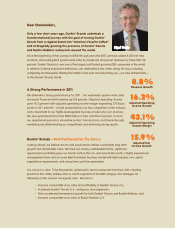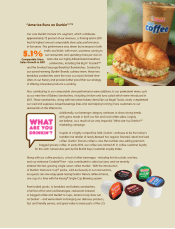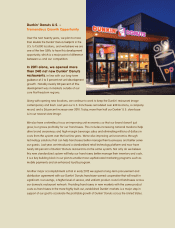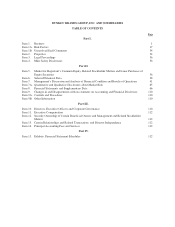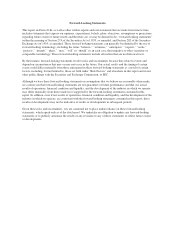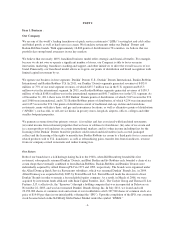Dunkin' Donuts 2011 Annual Report Download - page 12
Download and view the complete annual report
Please find page 12 of the 2011 Dunkin' Donuts annual report below. You can navigate through the pages in the report by either clicking on the pages listed below, or by using the keyword search tool below to find specific information within the annual report.
Our competitive business strengths
We attribute our success in the QSR segment to the following strengths:
Strong and established brands with leading market positions
We believe our brands have well-established reputations for delivering high-quality beverage and food products
at a good value through convenient locations with fast and friendly service. Today both brands are leaders in their
respective QSR categories, with aided brand awareness (where respondents are provided with brand names and
asked if they have heard of them) of 92% for Baskin-Robbins and 94% for Dunkin’ Donuts in the U.S., and a
growing presence overseas.
In addition to our leading U.S. market positions, for the sixth consecutive year, Dunkin’ Donuts was recognized
in 2012 by Brand Keys, a customer satisfaction research company, as #1 in the U.S. on its Customer Loyalty
Engagement IndexSM in the coffee category.
Franchised business model provides a platform for growth
Nearly 100% of our locations are franchised, allowing us to focus on our brand differentiation and menu
innovation, while our franchisees expand our points of distribution with operational guidance from us. Gross
store openings in fiscal 2011 were 374 for Dunkin’ Donuts U.S., 341 for Dunkin’ Donuts International, 571 for
Baskin-Robbins International and 49 for Baskin-Robbins U.S. Expansion requires limited financial investment
by us, given that new store development and substantially all of our store advertising costs are funded by our
franchisees. Consequently, we achieved an operating income margin of approximately 33% in fiscal 2011. For
our domestic businesses, our revenues are largely derived from royalties based on a percentage of franchisee
sales rather than their net income, as well as contractual lease payments and other franchise fees. We seek to
mitigate the challenges of a franchised business model, including a lack of direct control over day-to-day
operations in our stores and restaurant development, which could prevent us from being able to quickly and
unilaterally grow our business or scale back operations, through our team of more than 400 operational
employees who support our franchisees and restaurant managers along with our training and monitoring
programs.
Store-level economics generate franchisee demand for new Dunkin’ Donuts restaurants in the U.S.
In the U.S., new traditional format Dunkin’ Donuts stores opened during fiscal 2010, excluding gas and
convenience locations, generated average weekly sales of approximately $16,400, or annualized unit volumes of
approximately $855,000, while the average capital expenditure required to open a new traditional restaurant site
in the U.S., excluding gas and convenience locations, was approximately $474,000 in 2010. We offer our
franchisees significant operational support by aiming to continuously improve restaurant profitability. One
example is supporting their supply chain, where we believe we have facilitated approximately $247 million in
franchisee cost reductions between fiscal 2008 and 2011 primarily through strategic sourcing, as well as other
initiatives, such as rationalizing the number of product offerings to reduce waste and reducing costs on branded
packaging by reducing the color mix in graphics. We believe that the majority of these cost savings represent
sustainable improvements to our franchisees’ supply costs, with the remainder dependent upon the outcome of
future supply contract re-negotiations, which typically occur every two to four years. However, there can be no
assurance that these cost reductions will be sustainable in the future. While we do not directly benefit from
improvements in store-level profitability, we believe that strong store-level economics are important to our
ability to attract and retain successful franchisees and grow our business. Of our fiscal 2011 openings and
existing commitments, approximately 91% have been made by existing franchisees who are able, in many cases,
to use cash flow generated from their existing restaurants to fund a portion of their expansion costs.
As a result of Dunkin’ Donuts’ franchisee store-level economics and strong brand appeal, we are able to maintain
a robust new restaurant pipeline. During 2011, our franchisees opened 243 net new Dunkin’ Donuts points of
-2-


